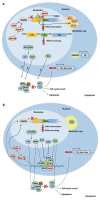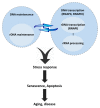The Nucleolus: In Genome Maintenance and Repair
- PMID: 28671574
- PMCID: PMC5535903
- DOI: 10.3390/ijms18071411
The Nucleolus: In Genome Maintenance and Repair
Abstract
The nucleolus is the subnuclear membrane-less organelle where rRNA is transcribed and processed and ribosomal assembly occurs. During the last 20 years, however, the nucleolus has emerged as a multifunctional organelle, regulating processes that go well beyond its traditional role. Moreover, the unique organization of rDNA in tandem arrays and its unusually high transcription rates make it prone to unscheduled DNA recombination events and frequent RNA:DNA hybrids leading to DNA double strand breaks (DSBs). If not properly repaired, rDNA damage may contribute to premature disease onset and aging. Deregulation of ribosomal synthesis at any level from transcription and processing to ribosomal subunit assembly elicits a stress response and is also associated with disease onset. Here, we discuss how genome integrity is maintained within nucleoli and how such structures are functionally linked to nuclear DNA damage response and repair giving an emphasis on the newly emerging roles of the nucleolus in mammalian physiology and disease.
Keywords: DNA repair; nucleolus; nucleus; ribosomal DNA.
Conflict of interest statement
The authors declare no conflict of interest.
Figures



Similar articles
-
Nucleolar responses to DNA double-strand breaks.Nucleic Acids Res. 2016 Jan 29;44(2):538-44. doi: 10.1093/nar/gkv1312. Epub 2015 Nov 28. Nucleic Acids Res. 2016. PMID: 26615196 Free PMC article. Review.
-
Recent advances in the nucleolar responses to DNA double-strand breaks.Nucleic Acids Res. 2020 Sep 25;48(17):9449-9461. doi: 10.1093/nar/gkaa713. Nucleic Acids Res. 2020. PMID: 32857853 Free PMC article. Review.
-
A localized nucleolar DNA damage response facilitates recruitment of the homology-directed repair machinery independent of cell cycle stage.Genes Dev. 2015 Jun 1;29(11):1151-63. doi: 10.1101/gad.260703.115. Epub 2015 May 27. Genes Dev. 2015. PMID: 26019174 Free PMC article.
-
Loss of nucleolar histone chaperone NPM1 triggers rearrangement of heterochromatin and synergizes with a deficiency in DNA methyltransferase DNMT3A to drive ribosomal DNA transcription.J Biol Chem. 2014 Dec 12;289(50):34601-19. doi: 10.1074/jbc.M114.569244. Epub 2014 Oct 27. J Biol Chem. 2014. PMID: 25349213 Free PMC article.
-
The nucleolus: a raft adrift in the nuclear sea or the keystone in nuclear structure?Biomol Concepts. 2013 Jun;4(3):277-86. doi: 10.1515/bmc-2012-0043. Biomol Concepts. 2013. PMID: 25436580 Free PMC article. Review.
Cited by
-
Nucleolar stress: Friend or foe in cardiac function?Front Cardiovasc Med. 2022 Oct 31;9:1045455. doi: 10.3389/fcvm.2022.1045455. eCollection 2022. Front Cardiovasc Med. 2022. PMID: 36386352 Free PMC article. Review.
-
The Nucleolus and PARP1 in Cancer Biology.Cancers (Basel). 2020 Jul 6;12(7):1813. doi: 10.3390/cancers12071813. Cancers (Basel). 2020. PMID: 32640701 Free PMC article. Review.
-
Ribosomal DNA instability and genome adaptability.Chromosome Res. 2019 Mar;27(1-2):73-87. doi: 10.1007/s10577-018-9599-7. Epub 2019 Jan 3. Chromosome Res. 2019. PMID: 30604343 Review.
-
Subcellular localization of the porcine deltacoronavirus nucleocapsid protein.Virus Genes. 2020 Dec;56(6):687-695. doi: 10.1007/s11262-020-01790-0. Epub 2020 Sep 17. Virus Genes. 2020. PMID: 32944812 Free PMC article.
-
LncRNA-Mediated Adipogenesis in Different Adipocytes.Int J Mol Sci. 2022 Jul 5;23(13):7488. doi: 10.3390/ijms23137488. Int J Mol Sci. 2022. PMID: 35806493 Free PMC article. Review.
References
-
- Hadjiolov A.A. The Nucleolus and Ribosome Biogenesis Cell Biology Monographs. Springer; New York, NY, USA: 1985.
-
- Fontana F. Traite sur le Venin de la Viper, sur les Poisons Americains, sur le Laurier-Cerise et sur Quelques Autres Poisons Vegetaux. Gibelin; Florence, Italy: 1781.
-
- Montgomery T. Comparative cytological studies, with especial regard to the morphology of the nucleolus. J. Morphol. 1898;15:265–582. doi: 10.1002/jmor.1050150204. - DOI
Publication types
MeSH terms
Substances
LinkOut - more resources
Full Text Sources
Other Literature Sources

